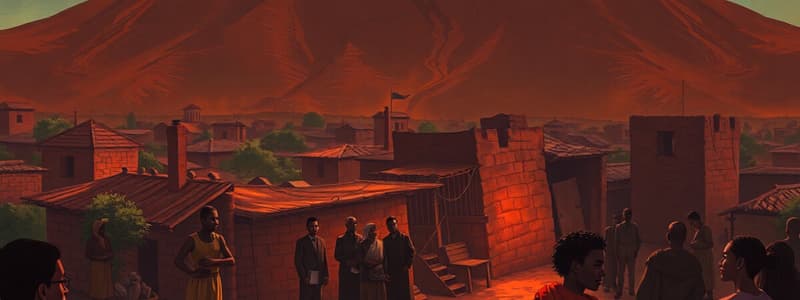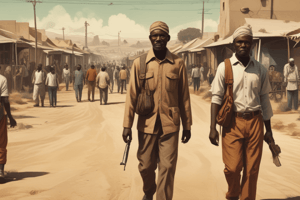Podcast
Questions and Answers
What role did peaceful resistance play in the anti-apartheid movement?
What role did peaceful resistance play in the anti-apartheid movement?
- It focused solely on economic boycotts.
- It was the only method used by activists.
- It was crucial in raising awareness and pressuring the government. (correct)
- It had little to no impact.
Who was released from prison in 1990, marking a turning point in the anti-apartheid movement?
Who was released from prison in 1990, marking a turning point in the anti-apartheid movement?
- Nelson Mandela (correct)
- Walter Sisulu
- Desmond Tutu
- Oliver Tambo
What significant political change occurred in South Africa in 1994?
What significant political change occurred in South Africa in 1994?
- The holding of democratic elections. (correct)
- The establishment of a socialist government.
- The end of all political resistance.
- The return to a colonial government.
What ongoing issue does the legacy of apartheid present in South Africa today?
What ongoing issue does the legacy of apartheid present in South Africa today?
Which factor contributed to the dismantling of apartheid laws?
Which factor contributed to the dismantling of apartheid laws?
What principle was the apartheid system in South Africa based on?
What principle was the apartheid system in South Africa based on?
Which racial categories were used to classify the population under apartheid?
Which racial categories were used to classify the population under apartheid?
What were the consequences of the Group Areas Act?
What were the consequences of the Group Areas Act?
Who predominantly held political power during the apartheid era?
Who predominantly held political power during the apartheid era?
What was one of the major forms of oppression under apartheid related to mobility?
What was one of the major forms of oppression under apartheid related to mobility?
How was education affected for non-white South Africans?
How was education affected for non-white South Africans?
What was the international community's response to apartheid?
What was the international community's response to apartheid?
Which tactic did the South African government use to maintain apartheid?
Which tactic did the South African government use to maintain apartheid?
Flashcards
Anti-apartheid movement
Anti-apartheid movement
A diverse group of activists, organizations, governments, and international groups that opposed apartheid in South Africa.
Nelson Mandela's leadership
Nelson Mandela's leadership
Crucial to the anti-apartheid movement, inspiring resistance and negotiation.
International sanctions
International sanctions
Economic penalties imposed on South Africa to pressure the government and end apartheid.
1990 Mandela release
1990 Mandela release
Signup and view all the flashcards
Dismantling of apartheid laws
Dismantling of apartheid laws
Signup and view all the flashcards
1994 democratic elections
1994 democratic elections
Signup and view all the flashcards
Apartheid legacy
Apartheid legacy
Signup and view all the flashcards
Apartheid Definition
Apartheid Definition
Signup and view all the flashcards
Separate Development
Separate Development
Signup and view all the flashcards
Racial Classification
Racial Classification
Signup and view all the flashcards
Segregation in Apartheid
Segregation in Apartheid
Signup and view all the flashcards
Discrimination Examples
Discrimination Examples
Signup and view all the flashcards
Pass Laws
Pass Laws
Signup and view all the flashcards
Reservations
Reservations
Signup and view all the flashcards
Group Areas Act
Group Areas Act
Signup and view all the flashcards
Political Disenfranchisement
Political Disenfranchisement
Signup and view all the flashcards
International Condemnation
International Condemnation
Signup and view all the flashcards
Anti-Apartheid Movement
Anti-Apartheid Movement
Signup and view all the flashcards
Study Notes
Introduction
- Apartheid was a system of racial segregation and discrimination enforced in South Africa from 1948 to 1994.
- The system was based on the principle of "separate development" which aimed to create separate, unequal societies for the different racial groups.
- This policy subjected non-white South Africans to severe limitations and oppression.
Key Features of Apartheid
- Racial Classification: The population was divided into four racial categories: White, Black, Coloured, and Indian. This classification determined legal rights and social opportunities.
- Segregation: A rigid system of segregation pervaded all aspects of life, including residential areas, public facilities, transportation, education, and employment. Non-whites were confined to inferior areas and facilities.
- Discrimination: The system denied non-whites equal rights and opportunities. They faced systematic discrimination in housing, employment, healthcare, and education.
- Political Disenfranchisement: Non-white people were largely excluded from political processes. Only white citizens had the right to vote and hold office. This created a vast power imbalance.
Forms of Oppression
- Pass Laws: Black South Africans were required to carry passbooks at all times, documenting their movements and restricting their access to urban areas.
- Reservations: Large amounts of land were taken from black South Africans and put into reserves, greatly reducing their economic opportunities.
- Group Areas Act: This act forced the segregation of populations into specific residential areas based on racial classifications. This led to the forced removal and resettlement of many communities.
- Limited Educational Opportunities: Education for non-whites was significantly inferior to that of white South Africans. Funding and resources were disproportionately distributed.
- Violence and Repression: The government used repressive tactics, including police brutality, to maintain the system of apartheid. Protests by anti-apartheid activists were often met with violence.
International Condemnation
- The system of apartheid became internationally condemned as a violation of human rights.
- Many countries imposed sanctions against South Africa, including trade restrictions, attempting to pressure the government to change its policies.
Anti-Apartheid Movement
- Significant international and domestic opposition formed against the apartheid regime. The anti-apartheid movement included activists, civil rights organizations, governments, and international pressure groups.
- Peaceful resistance and demonstrations played a critical role in raising awareness and pressuring the South African government. Nelson Mandela's leadership was crucial.
End of Apartheid
- The pressure of international sanctions and domestic resistance progressively took effect.
- In 1990, Nelson Mandela was released from prison.
- Negotiations and reforms led to the dismantling of apartheid laws, including the establishment of a multiracial government and the holding of democratic elections in 1994.
- The transition was complex, but marked a turning point in South African history.
Legacy of Apartheid
- The legacy of apartheid remains a significant issue in South African society, with persistent inequalities and challenges of reconciliation still evident today.
- Efforts are continually made to address the social and economic consequences of this discriminatory system.
Studying That Suits You
Use AI to generate personalized quizzes and flashcards to suit your learning preferences.




